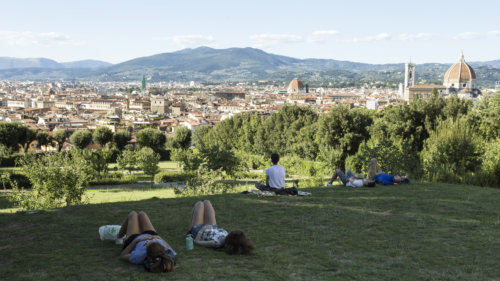Exploring Italy’s Giardino di Boboli
When I moved to Florence, Italy for a year to study art, I quickly learned that tourists are a common frustration for locals. With their selfie-sticks and knockoff handbags in tow, tourists are ubiquitous in this historic city. The Pitti Palace (Palazzo Pitti), a complex of museums situated on the south side of the Arno River (Oltrarno), is no exception. But while tourists flock to the former residence of generations of Florentine royals, they often overlook one of the palace’s most beautiful attractions: the Boboli Gardens (Giardino di Boboli). Seeking respite from the crowded and grey city, I pass under the palace’s archway, cross its courtyard, and climb a hill of steps. As I round the corner at the top of the staircase, the gardens come into view. I’ve stepped into another world – one from centuries ago.
“After a year in Florence, I found myself habituating to the many beautiful and ancient places in this historic city– but I never grew indifferent to the distinct wonder of the Boboli Gardens.”
The Boboli Gardens display a rich and ancient history. Construction began in the 15th century, when the Borgolo family laid out fields and gardens behind the Church of Saint Felicity (Santa Felicita). In 1418, Messer Luca Pitti purchased these properties, commissioning the original Pitti Palace for his family in 1458. Almost a century later, the wife of Cosimo I de’ Medici, Grand Duke of Tuscany, bought the estate in 1549. As the new city residence of the grand ducal Medici family, the gardens were vastly expanded by court architects and ultimately, finished under the rule of Cosimo I’s son, Francesco I. Over the next three centuries, the Medici and the Lorraine royal families continued to enlarge the gardens into the modern day outdoor museum, which continues to exhibit Roman and Renaissance statues.
The gardens’ entrance gives way to one of its main attractions: the Amphitheater. Its towering hedges hold statues based on Roman myths. At its center stands an Egyptian obelisk, brought from Luxor and placed in 1789. A paved path leads from the Amphitheater up a hill to the Neptune Fountain, a small pond featuring a sculpture of the Roman sea god by Stoldo Lorenzi. I venture further into the gardens, and eventually reach a statue called “Abundance,” fashioned by the sculptor Giambologna to represent Francesco I’s wife.
I realize that while I will never be able to escape the packs of tourists in Florence, their presence is somehow mitigated by the gardens.
Giambologna’s statue marks the top of the hill. When I turn around, repositioning myself to glimpse a better view, I can see beyond the gardens and the Pitti Palace, across the Arno River to the north side of the city. As I look down at the gardens, I notice the usual tourist characters are mixed with more local ones: Florentine high school students on a school field trip, a couple napping on a blanket, the solitary young person reading under the shade of several cypress and oak trees. I realize that while I will never be able to escape the packs of tourists in Florence, their presence is somehow mitigated by the gardens. Maybe it is the quiet, which is so hard to find in the rest of the city bustling on the other side of the palace’s walls.
As I descend the hill, I veer off down one of the gardens’ many hidden paths. I discover that this particular route leads to another hill, atop which sits the Kaffeehaus, a grand pavilion added by the Lorraine family in 1776. A bit more hidden than the main hill, this spot affords more personal views of the city, including an idyllic vista of the famous Duomo.
I make my way back towards the Amphitheater and cross over to the west side of the garden, where I encounter a statue of the winged horse Pegasus and a large stone bathtub. Across the terrace from these sculptures is the palace’s Costume Gallery. As I return to the gardens’ entrance, I head back down the tunnel from which I came. Although there’s much more to explore in the hidden nooks and paths of the gardens, I decide to save these adventures for the rest of my time in Florence.
While the Boboli Gardens remain unique in Florence, they are just one of many examples of Europe’s “green architecture.” As one of the first, the Boboli Gardens inspired many other European gardens, perhaps most notably, the gardens of the Palace of Versailles– a point of anthropological intrigue for garden travel completionists. Gardens like Boboli offer a much-needed sanctuary that can be fleeting or absent in major tourist cities like Florence. After a year in Florence, I found myself habituating to the many beautiful and ancient places in this historic city– but I never grew indifferent to the distinct wonder of the Boboli Gardens. The Boboli Gardens stand alone in their ability to preserve nature and serenity in one of the most tourist-heavy, urban cities in the world– and that marvel alone makes them more than worth the trip.




































